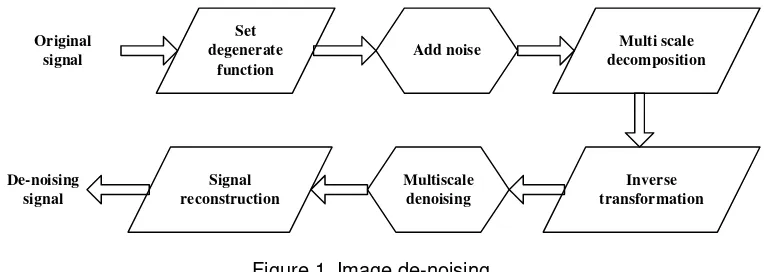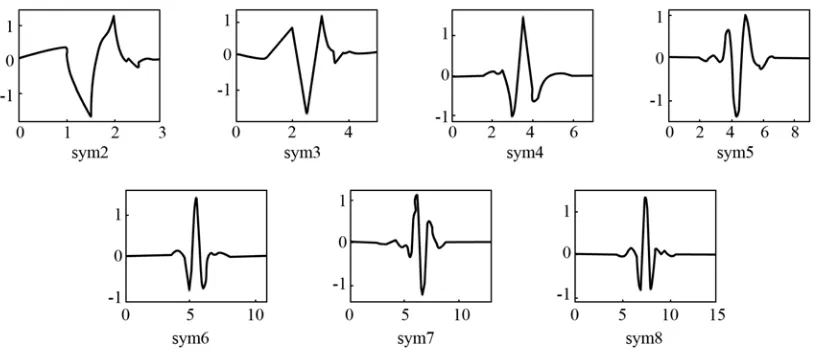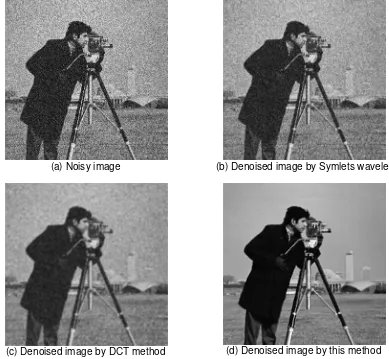DOI: 10.12928/TELKOMNIKA.v13i4.1897 1312
Image Denoising Based on K-means Singular Value
Decomposition
Jian Ren*, Hua Lu, Xiliang Zeng
Hunan University of International Economics, Changsha 410205, Hunan, China *Corresponding author, e-mail:[email protected]
Abstract
The image is usually polluted by noises in its acquisition and transmission and noises are of great importance in the image quality, therefore, image de-noising has become a significant technique in image analysis and processing. In the image de-noising based on sparse representation, one of the hot spots in recent years, the useful image information has certain structural features, which coincide with the atomic structure while noises don’t have such features, therefore, sparse representation can separate the useful information from the noises effectively so as to achieve the purpose of de-noising. In view of the above-mentioned theoretical basis, this paper proposes an image de-noising algorithm of sparse representation based on K-means Singular Value Decomposition (K-SVD). This method can integrate the construction and optimization of over-complete dictionary, train the atom dictionary with the image samples to be decomposed and effectively build the atom dictionary that reflects various image features to enhance the de-noising performance of the algorithm in this paper. Through simulation analysis, this method can conduct noise filtration on the image with different noise densities and its de-noising effect is also better than other methods.
Keywords: Image De-noising, K-means Singular Value Decomposition, Sparse Representation
Copyright © 2015 Universitas Ahmad Dahlan. All rights reserved.
1. Introduction
The image in reality usually contains noises, which not only greatly affect the image quality, but also bring many difficulties to the subsequent image processing; therefore, image de-noising has become very important in image processing. Noises can be any factors that prevent people from understanding or analyzing the image sources they receive with their visual organ or the system sensors [1]. The common noises are unpredictable random signals, which can only be known via probability statistics. Noises are very significant in image processing and they affect every link of the input, collection and processing of image processing as well as the entire process of the result output. Image de-noising can reduce or eliminate the noises mixed in the image to certain extent and preserve the detailed image information so as to store the image to higher quality. It still remains an important topic in image pre-processing how to use certain technology to remove image noises and preserve the image details [2].
This paper first illustrates the traditional image and noises, introduces the relevant de-noising methods and techniques and explores the relevant sparse representation algorithms and techniques based on the theory of sparse representation and Discrete Cosine Transform (DCT) dictionary. Then, based on sufficient theory and techniques, it raises new image de-noising algorithm based on K-SVD and multiple dictionaries. Finally, it verifies the effectiveness of this algorithm through experimental simulation.
2. Image and Noises
Image, the vision of two or three-dimensional scene in human eyes, is the main medium for people to convey information. With its advantages such as large amount of information, rapid transmission and long operating distance, image has become an important source and means for people obtain and use information. Since image is interfered by various noises in the generation and transmission, the image quality will be damaged, which is harmful to the follow-up higher-level image processing. Many factors will affect the image quality in the basic steps of image acquisition, coding, transmission and restoration. For example, the useless information in real image are noises and such elements as the equipment, the environment and the acquisition methods can also bring in many noises, including the electromagnetic interference, the granular noises, the sensor noises in collecting image signals, the inter-channel noises and even the filter noises. So, in order to improve the image quality and the subsequent higher-level processing, it has been an important link to de-noise the image and people have been searching for a feasible de-noising method [6, 7].
Noises can be seen as the elements which hamper people’s sense organ from understanding the information they receive. The interference the image suffers from its generation and transmission has played great influence on signal processing, transmission and storage. Image denoising is an important image processing task, both as a process itself, and as a component in other processes. Very many ways to denoise an image or a set of data exists. The main properties of a good image denoising model are that it will remove noise while preserving edges. Assuming that the degenerative image f x y( , ) can be obtained by degenerating the input image g x y( , ), set a degenerate function in the original image and adds an additive noise item m x y( , ). As for the degeneration process with linearity and location invariance, the degeneration model in the spatial domain can be indicated as (1):
( , ) ( , ) ( , ) ( , )
f x y h x y g x y m x y (1)
In Formula (1), h x y( , ) is the spatial description of the degenerate function. Through the spatial convolution of the degenerate function and the original image, the spatial degenerative image can be obtained and the degeneration process will be completed within addictive noise after the degeneration [8, 9]. Image restoration is to restore the original image g x y( , ) by analyzing the degeneration model and formulating the inverse process. See the image de-noising model in Figure 1.
3. Sparse Representation Theory
In signal sampling, sparse representation theory completes the sparse coding during the sampling. Generally, sparse representation uses over-complete redundant function dictionary as the base function instead of the traditional standard orthogonal basis. The dictionary selection shall coincide with the structure of the signals to be approximated as possible and the elements in the dictionary are called atoms. Signal reconstruction is the inverse process of sparse coding. When the sparse representation theory reconstructs the signal, it considers the original signals as unknown ones and gets the reconstructed signals through the product of sparse coefficients and the corresponding dictionary. The sparse signals in the redundant dictionary can be restored from the few random observation values via certain algorithms, namely that after adopting the redundant dictionary, the sparsity of the signals can be enhanced and the signals can be restored from fewer observation at higher probability. Signal sparse decomposition can reduce the cost of signal processing while preserving the main characteristics [10, 11].
Signal sparse decomposition refers to the acquisition process of the optimal sparse representation or sparse approximation of the signals in the over-complete dictionary, namely that the signal can be represented in the form of the product of a group of sparse coefficients and the training dictionary. The more zeros or approximate zeros in the vector values of the sparse coefficients, the sparser the signal representation is. The signal with N non-zeros in the vector values of the sparse coefficients is called N-sparse signal. According to the relevant contents of sparse theory, all signals can be sparsely represented, namely compressed. The sparse decomposition algorithm and the design of the sparse dictionary are the two main aspects of sparse representation [12]. From the above analysis, the general procedures of image de-noising based on sparse decomposition can be summarized as follows:
(1) Construct the over-complete dictionary of atoms. The performance of the construction of atom dictionary can directly affect the sparsity of the image sparse decomposition and it determines the image de-noising.
(2) Image sparse decomposition. Conduct sparse decomposition on the image in the over-complete dictionary of atoms by using decomposition algorithms such as OMP algorithm. In this process, attention shall be paid to the end conditions of decomposition, namely what circumstance can be seen as the fact that the effective information of the image has been extracted completely. While guaranteeing as much as effective information to be extracted, the sparsity of the image representation shall also be taken into consideration. As the core stage in image de-noising, the computation in this stage is usually very huge and the sparse coefficient matrix of the image can be obtained and the effective atom set can be extracted [13].
(3) Reconstruction of de-noised image. Reconstruct the image with the sparse coefficient matrix and the effective atom set and get the de-noised image.
Assume that the signal to be decomposed is y and the over-complete dictionary is D and then the sparse decomposition of the image signal can be described as follows:
2 y——sparse representation coefficient and
0
y is the number of non-zero coefficients iny,
——trade-off parameter between the control residue and sparsity.
In Formula (2), the first item is a square error, meaning the error between the product of the sparse vector after the sparse decomposition and the over-complete dictionary and the original signalx. According to the definition of L0 norm, the second item in the formula is the number of non-zero elements in the sparse representation coefficient y. The smaller
0
the fewer non-zeros and the more sparse the presentation of y is. Seek the above-mentioned optimization problem and get the sparse representation of the original signal [14, 15].
4. The Image De-noising Process Based on K-SVD
K-SVD algorithm trains the over-complete dictionary which is suitable to represent the semantic structure of the image from the natural image library. The main idea for the optimization and update of K-SVD dictionary is: based on the over-complete dictionary, update and adjust the atoms in the dictionary continuously so as to match the signal set to be trained to the utmost extent. Additionally, K-SVD algorithm can be used together with many other decomposition algorithms and different approximation algorithms can be used flexibly in training the dictionary in K-SVD algorithm. The main procedures of K-SVD algorithm are as follows:
Input: extract pixel blocks and form training sample set in the noisy image from the top point to the end point of the image matrix according to a certain step length. The training sample set is D
d d1, 2,,dN
, the original image signal is x and the sparsity is K. (2) Sparse representation of signalsThe algorithm performs sparse decomposition on the noisy image in the initial dictionary D and an over-complete dictionary matrix n K
DR can be obtained. Every column represents the atoms of an original signal. Given a signaly, it can be represented as the sparsity combination of these atoms. The image signal y can be represented as yDx or yDx,
satisfying
p
yDx . The so-called over-completeness in the dictionary matrix means that
the number of atoms is much bigger than the length of the image signal y (obviously the length is n), namely nk. The dictionary update is conducted by column. When updating a certain column of dictionary elementdi, assume that the coefficient matrix X and the dictionary D are known and fixed.
(3) Update the dictionary D by column
Assuming that the coefficient X and the dictionary D are fixed, if the dk in the kth column of the dictionary is to be updated, K-SVD algorithm is the kth column of the product of the sparse matrix X and dk, then the objective function is as follows:
(4) SVD method decomposes the matrix k R
(5) After obtaining the dictionaryD , repeat Step (2)-(4) and update the dictionary by column until all columns have been updated and the end conditions of iteration are achieved.
(6) Output the over-complete dictionaryD.
5. Experimental Design and Result Analysis
In order to verify the effectiveness and superiority of this algorithm of this paper in the low-signal-to-noise-ratio image, this paper compares the de-noising effect by the algorithm of this paper and the effects by another 2 de-noising algorithms: the image de-noising algorithm based on Symlets wavelet hard threshold and method based on DCT over-complete atom dictionary. The symlets are nearly symmetrical wavelets proposed by Daubechies as modifications to the db family [16]. The properties of the two wavelet families are similar. Here are the wavelet functions as shown in the following Figure 2.
Figure 2. Symmetrical wavelets
With the Cameraman image as example, this paper conducts experimental simulation and research analysis. The image Cameraman has more smooth regions and abundant detail textures and it also has strong representativeness in de-noising processing. The following is the analysis of the simulation result. Figure 3 is the de-noised images by the foregoing de-noising methods.
(a) Noisy image (b) Denoised image by Symlets wavelet
(c) Denoised image by DCT method (d) Denoised image by this method
Figure 3. Denoised Cameraman images by different denoising methods
6. Conclusion
This paper has come up with problems in image de-noising, used the idea of sparse decomposition, tried by integration DCT over-complete dictionary of atoms and K-SVD algorithm and compared the advantages and disadvantages in various aspects of the de-noising and preservation of image details through theoretical analysis and experimental simulation. The result has shown that the algorithm of this paper has been image de-noising effect and strong robustness.
References
[1] YT Shih, CS Chien CY. Chuang. An Adaptive Parameterized Block-based Singular Value Decomposition for Image De-Noising and Compression. Applied Mathematics and Computation. 2012; 218(21): 10370-10385.
[2] Nasrin M Makbol, Bee Ee Khoo. A New Robust and Secure Digital Image Watermarking Scheme Based on The Integer Wavelet Transform and Singular Value Decomposition. Digital Signal Processing. 2014; 33(10): 134-147.
[3] Nasrin M.Makbol, Bee Ee Khoo. Robust Blind Image Watermarking Scheme Based on Redundant Discrete Wavelet Transform and Singular Value Decomposition. AEU-International Journal of Electronics and Communications. 2013; 67(2): 102-112.
[5] Sankaralingam Esakkirajan, Chinna Thambi Vimalraj, Rashad Muhammed, Ganapathi Subramanian. Adaptive Wavelet Packet-Based De-speckling of Ultrasound Images with Bilateral Filter. Ultrasound in Medicine & Biology. 2013; 39(12): 2463-2476.
[6] Yuying Shi, Yonggui Zhu, Jingjing Liu. Semiimplicit Image Denoising Algorithm for Different Boundary Conditions. TELKOMNIKA Indonesian Journal of Electrical Engineering. 2013; 11(4): 2058-2063. [7] PY Sacré, C De Bleye, PF Chavez, L Netchacovitch, Ph Hubert, E Ziemons. Data Processing of
Vibrational Chemical Imaging for Pharmaceutical Applications. Journal of Pharmaceutical and Biomedical Analysis. 2014; 101(12): 123-140.
[8] Chathurika Dharmagunawardhana, Sasan Mahmoodi, Michael Bennett, Mahesan Niranjan. Gaussian Markov Random Field Based Improved Texture Descriptor for Image Segmentation. Image and Vision Computing. 2014; 32(11): 884-895.
[9] Elnara Nasimi, Hossam A Gabbar. Signal De-Noising Methods for Fault Diagnosis and Troubleshooting at CANDU Stations. Nuclear Engineering and Design. 2014; 280(12): 481-492. [10] Nedumaran Damodaran, Sivakumar Ramamurthy, Sekar Velusamy, Gayathri Kanakaraj Manickam.
Speckle Noise Reduction in Ultrasound Biomedical B-Scan Images Using Discrete Topological Derivative. Ultrasound in Medicine & Biology. 2012; 38(2): 276-286.
[11] Rajib Kumar Jha, Rajlaxmi Chouhan. Dynamic Stochastic Resonance-based Grayscale Logo Extraction in Hybrid SVD-DCT Domain. Journal of the Franklin Institute. 2014; 351(5): 2938-2965. [12] William K. Allard, Guangliang Chen, Mauro Maggioni. Multi-scale Geometric Methods for Data Sets II:
Geometric Multi-resolution Analysis. Applied and Computational Harmonic Analysis. 2012; 32(3): 435-462.
[13] M Sabarimalai Manikandan, S Dandapat. Wavelet-based Electrocardiogram Signal Compression Methods and Their Performances: A Prospective Review. Biomedical Signal Processing and Control. 2014; 14(11): 73-107.
[14] Samuel Vaiter, Charles-Alban Deledalle, Gabriel Peyré, Charles Dossal, Jalal Fadili. Local Behavior of Sparse Analysis Regularization: Applications to Risk Estimation. Applied and Computational Harmonic Analysis. 2013; 35(3): 433-451.
[15] Mohan, V Krishnaveni, Yanhui Guo. A Survey on the Magnetic Resonance Image Denoising Methods. Biomedical Signal Processing and Control. 2014; 9(1): 56-69.


